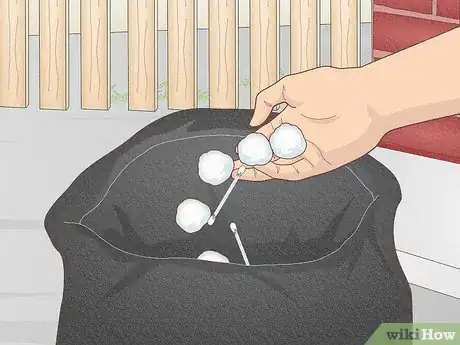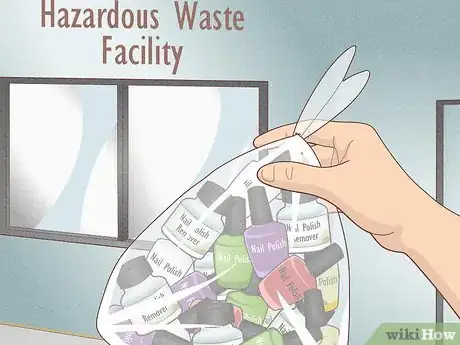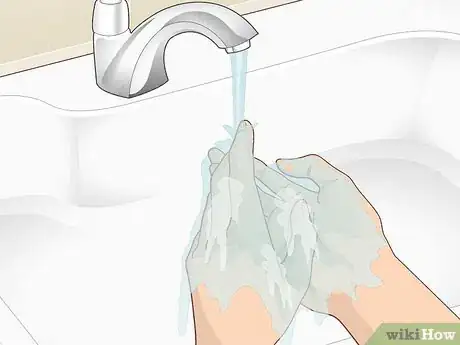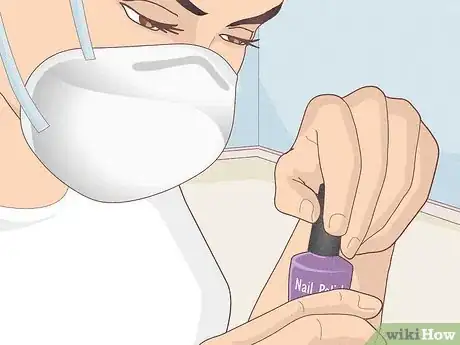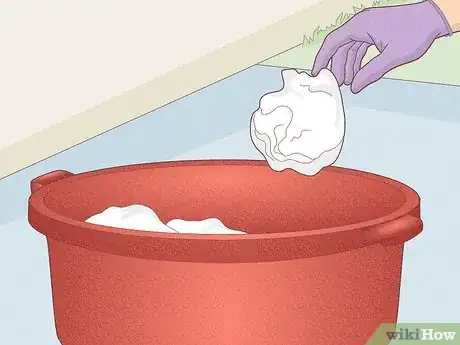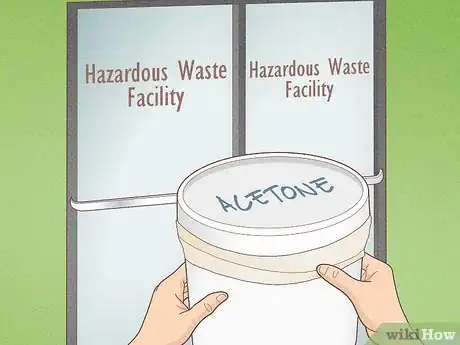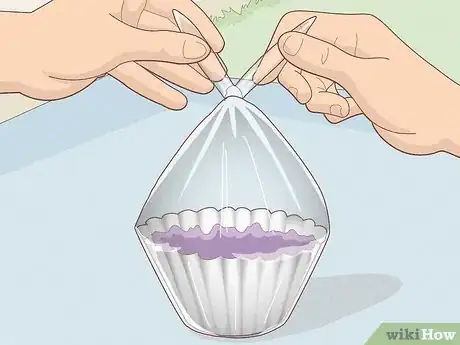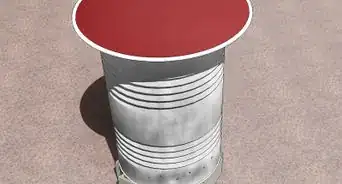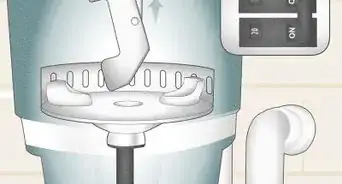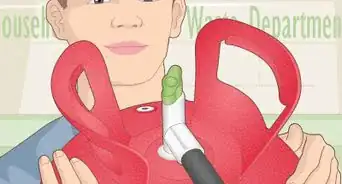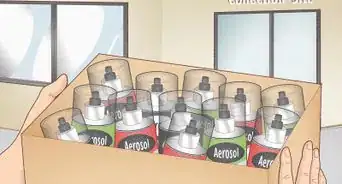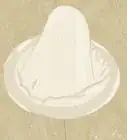This article was co-authored by Gregory Cade, JD. Gregory Cade is an Environmental and Occupational Law Attorney. With over 25 years of experience, he has extensive knowledge in injuries resulting from toxic substance exposure like pesticides. He is a member of numerous professional organizations, including The American Bar Association, The National Association of Environmental Professionals, and The American Association for Justice. Gregory graduated with a BS in Natural Science and Mathematics with an emphasis in Chemistry and Biology and an MPH in Occupational Health, Safety, and Industrial Hygiene from The University of Alabama at Birmingham. He also holds a JD from Miles School of Law.
This article has been viewed 138,909 times.
Acetone is a hazardous solvent that can cause health and environmental problems when not recycled correctly. If you work in a nail salon or use it to clean coins, you need to wash your hands and dispose of the acetone cleaner in proper containers. Store soaked rags in bins and take them to hazardous waste facilities. Paint thinner needs to be strained into a sealed jar and placed in a metal garbage bin that’s been hammered closed.
Steps
Disposing of Acetone Cleaning Products
-
1Put small amounts of acetone in a garbage bag. Put the cotton balls or swabs in a small garbage bag, tie the bag securely, and put it in the garbage. Wash your hands of any remaining acetone after handling cotton balls.
- If the cotton balls are saturated in nail polish remover, remember to wring them out into a separate container with a secure lid. Throw out that container as a hazardous waste.[1]
- Use trashcans with self-opening and closing lids to avoid exposure to acetone and other hazardous wastes that you throw away.[2]
-
2Take old nail polish and nail polish remover to a hazardous waste facility. If you have bottles of nail polish and remover your salon no longer wants, put these in separate containers from the rest of your recycling. Bring those containers to a hazardous waste, treatment, disposal, or recycling facility, or Toxic Substances and Disease Registry (TSDR).[3]
- You can find a TSDR facility through the EPA’s RCRAInfo search here https://www3.epa.gov/enviro/facts/rcrainfo/search.html by searching specific geographic locations, zip codes, or a facility name if you know it.
- Don’t pour acetone nail polish remover in the drain or toilet.
- Avoid putting large amounts of acetone in the regular garbage.
Advertisement -
3Take leftover acetone to the hazardous waste facility. Seal it in a leak-proof container kept away from anything that could ignite it. Acetone is combustible, so keep it away from hot surfaces and open flames.[4]
- If you use acetone to clean coins, you can strain any solids out and reuse it. You can also dispose of it at a hazardous waste facility in the proper containers.
-
4Wash your hands after using an acetone product. This is a very important part of acetone disposal. Even after you throw away and store all products, washing your hands is critical to your health. You don’t want that harmful chemical on your hands while you eat during your lunch break! Scrub your hands with soap and water after handling nail polish remover.[5]
- If possible, step outside for a breath of fresh air. You need a break from the salon chemicals or you may experience symptoms such as dizziness and headaches.
-
5Close containers and wear masks to stay safe from fumes. When you’re not using an acetone product, close it securely. If it’s a bottle of nail polish remover, make sure the cap is screwed on tightly enough so it doesn’t leak out.[6]
- Reduce your exposure to acetone fumes by wearing a special mask with an air filter in it. The mask must be NIOSH approved. One type of mask is the N95 which filters out some acrylic powders, dust, germs, and some chemical odors. However, it doesn’t filter every chemical.[7]
- Another type of mask to wear is a half-mask respirator. This will filter out acetone fumes, as well as all other harmful toxic odors.
Getting Rid of Acetone-Soaked Rags
-
1Collect soaked rags in hazardous waste bins. If you work in a university laboratory or art department, the guidelines require that you put acetone-covered rags in hazardous waste drums, pails, and red safety cans. Acetone is flammable, so if you have rags soaked with acetone paint thinner, place them in a tightly sealed container with water. Hammer the edges of the lid to seal it tightly.[8]
- You can purchase this type of container at any home improvement store.
- If possible, dry the rags in a well-ventilated area with no wind to blow them away. After they’re dried, put them in a fireproof pouch to transport them to the hazardous waste center.
-
2Contact your university to pick up these bins. When you need your acetone waste collected, contact the university you work at to pick up hazardous waste materials. For instance, Purdue has a form for you to fill out at this link: https://purdue.qualtrics.com/jfe/form/SV_eILaSqsoqODWxOl
-
3Take your soaked rags to a hazardous waste facility. If you have unused acetone products, take it to your local hazardous waste facility. Make sure it’s sealed in a hazardous waste container to prevent leakage.[9]
- You can also call the waste management facility to see if you can arrange a pickup.
- Your community may have regular waste collection events, so check in with your local government to find out when those take place.
Throwing Away Acetone Paint Thinner
-
1Locate your local hazardous waste facility. With a simple online search for your local facility, you should be able to find its guidelines for dropping off acetone. Different, cities, and countries will have different guidelines, so be sure read what your local facility requires of you.[10]
- The Environmental Protection Agency (EPA) provides information about how to search for a local hazardous waste removal facility. They provide a link to search in the Resource Conservation and Recovery Act Information (RCRAInfo).[11]
-
2Strain acetone paint thinner through a coffee filter and jar. Pour used paint thinner through a coffee filter over a jar. Paint will accumulate in the filter, and the thinner will drain cleanly into the jar. Close the lid tightly and bring it to your local hazardous waste facility.[12]
- Allow the coffee filters and paint to dry. Then wrap them in newspaper before throwing them in the trash.
- You can also reuse the paint thinner. Be sure to label the jar stating what kind of paint thinner it is and the date it was strained.
-
3Dry the remaining paint and wrap it up. Let the paint harden after it settles in the coffee filter. Let the paint harden before you throw it away. Wrap it in newspaper or plastic bags and toss it in the normal trash once it’s completely dry.[13]
- Always wear gloves and a mask to protect yourself from the fumes in paint thinner.
Warnings
- If you’re working in a nail salon, don’t wear a regular dust mask stuffed with tissues, as this won’t protect your from harmful acetone fumes.[14]⧼thumbs_response⧽
- Don’t leave acetone on a hot surface or near an open flame, because it’s highly flammable in liquid and vapor form.⧼thumbs_response⧽
References
- ↑ http://www.hazwastehelp.org/Health/documents/How-to-Handle-Nail-Salon-Waste.pdf
- ↑ https://www.osha.gov/Publications/3542nail-salon-workers-guide.pdf
- ↑ http://www.hazwastehelp.org/Health/documents/How-to-Handle-Nail-Salon-Waste.pdf
- ↑ https://www.oregonmetro.gov/tools-living/healthy-home/common-hazardous-products/paint-thinners
- ↑ https://www.osha.gov/Publications/3542nail-salon-workers-guide.pdf
- ↑ https://www.osha.gov/Publications/3542nail-salon-workers-guide.pdf
- ↑ https://www.osha.gov/Publications/3542nail-salon-workers-guide.pdf
- ↑ https://www.bobvila.com/articles/how-to-dispose-of-paint-thinner/
- ↑ https://www.oregonmetro.gov/tools-living/healthy-home/common-hazardous-products/paint-thinners
- ↑ https://www.bobvila.com/articles/how-to-dispose-of-paint-thinner/
- ↑ https://www.epa.gov/hwpermitting/how-do-i-find-hazardous-waste-management-facilities-my-area
- ↑ https://www.bobvila.com/articles/how-to-dispose-of-paint-thinner/
- ↑ https://fonddulac.uwex.edu/files/2012/01/Paint-and-Other-Home-Improvement-Products.pdf
- ↑ https://www.osha.gov/Publications/3542nail-salon-workers-guide.pdf
About This Article
Acetone is a hazardous solvent, so you’ll have to dispose of it safely. If you have any leftover acetone, nail polish, nail polish remover, or rags soaked in acetone, take them to a hazardous waste facility or Toxic Substances and Disease Registry. You can find a local facility on the EPA’s Resource Conservation and Recovery Act info page. If you need to dispose of acetone paint thinner, strain it through a coffee filter into a jar. Then, close the lid and store the paint thinner for reuse or take it to a hazardous waste facility. When the paint in the filter is dry, wrap it in newspaper and throw it in the trash. If you have any cotton balls that you’ve soaked in small amounts of acetone, you can put these in the regular trash too. For more tips, including how to dispose of acetone in a university lab or art department, read on!
